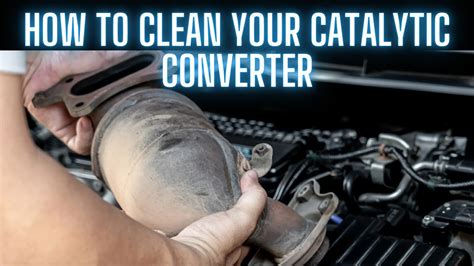How To Clean a Catalytic Converter: A Comprehensive Guide
A clogged catalytic converter can significantly impact your vehicle's performance, leading to reduced fuel efficiency, decreased power, and even engine damage. While replacement is often the recommended solution, cleaning your catalytic converter might be a viable option, depending on the cause and extent of the blockage. This guide explores methods for cleaning a catalytic converter, emphasizing important cautions and when professional help is necessary.
Understanding Your Catalytic Converter
Before diving into cleaning methods, it's crucial to understand what a catalytic converter does and why it might become clogged. The catalytic converter is part of your vehicle's emission control system. It uses a chemical process to convert harmful exhaust gases (like carbon monoxide, hydrocarbons, and nitrogen oxides) into less harmful substances (carbon dioxide, water vapor, and nitrogen). Clogging typically occurs due to:
- Fuel System Problems: A rich fuel mixture (too much fuel, not enough air) can lead to unburnt fuel accumulating in the converter.
- Engine Misfires: Misfires send raw fuel into the exhaust system, contributing to buildup.
- Overheating: Excessive heat can damage the catalyst material, leading to reduced efficiency and potential clogging.
- Physical Blockages: Sometimes, foreign objects can enter the exhaust system and obstruct the converter.
Can You Really Clean a Catalytic Converter?
The short answer is: sometimes. Minor clogging might be addressed with cleaning, but severely damaged or completely blocked converters usually require replacement. Cleaning is a more viable option if the clogging is due to fuel system issues or minor buildup, not significant physical damage. Attempting to clean a severely damaged converter may be futile and even damage it further.
Methods for Cleaning a Catalytic Converter
Disclaimer: These methods are for informational purposes only. Improper cleaning can damage the converter or expose you to harmful substances. Proceed with caution and at your own risk.
Method 1: Chemical Cleaning (for minor clogging)
This method involves using a specialized catalytic converter cleaner available at some auto parts stores. Always follow the manufacturer's instructions precisely. Typically, this involves injecting the cleaner into the exhaust system and letting it soak for a specified period. Afterward, you might need to run the engine for a while to flush the cleaner through. This method is best for minor buildup and may not be effective for severe clogging.
Method 2: Soaking (Not Recommended for most cases)
Some individuals try soaking the converter in a solvent (like a specialized cleaner designed for this purpose). This method is generally not recommended because it's difficult to ensure complete cleaning and proper drying. Improper drying can lead to further damage. This method is highly discouraged unless you have specialized equipment and knowledge.
When to Seek Professional Help
If you notice any of the following symptoms, it's best to consult a mechanic:
- Significant reduction in fuel economy: A large drop in your MPG suggests a serious problem.
- Loss of engine power: The car struggles to accelerate or maintain speed.
- Exhaust smell: An unusual or strong exhaust odor may indicate catalytic converter issues.
- Check engine light: A consistently illuminated check engine light often signals a problem with the emission system.
Preventative Maintenance
The best approach is preventative maintenance. Regular vehicle maintenance, including timely tune-ups and addressing fuel system problems promptly, can significantly extend the life of your catalytic converter and reduce the likelihood of needing to clean it.
In summary: While cleaning a catalytic converter might be possible in some cases, it's important to assess the situation carefully. For severe clogging or damage, replacement is the most reliable solution. Always prioritize safety and consider professional help when needed. Preventative maintenance is key to avoiding costly repairs.
